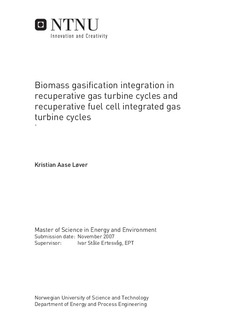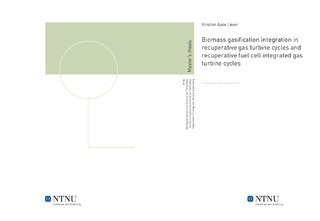| dc.description.abstract | A multi-reactor, multi-temperature, waste-heat driven biomass thermochemical converter is proposed and simulated in the process simulation tool Aspen Plus . The thermochemical converter is in Aspen Plus integrated with a gas turbine power cycle and a combined fuel cell/gas turbine power cycle. Both power cycles are recuperative, and supply the thermochemical converter with waste heat. For result comparison, the power cycles are also integrated with a reference conventional single-reactor thermochemical converter, utilizing partial oxidation to drive the conversion process. Exergy analysis is used for assessment of the simulation results. In stand-alone simulation, the proposed thermochemical shows high performance. Cold gas efficiency is 108.0% and syngas HHV is 14.5 MJ/kg on dry basis. When integrated with the gas turbine power cycle, the proposed converter fails to improve thermal efficiency of the integrated cycle significantly, compared to reference converter. Thermal efficiency is 41.8% and 40.7%, on a biomass HHV basis, with the proposed and the reference converter respectively. This is despite superior cold gas efficiency for the proposed converter, and the gas turbine cycle is found not to be able to properly take advantage of the high chemical energy in the syngas of the proposed converter. When integrated with the combined fuel cell/gas turbine power cycle, the proposed converter significantly improves the thermal efficiency of the integrated cycle, compared to the reference converter. Thermal efficiency is 56.0% and 51.2%, on a biomass HHV basis, with the proposed and the reference converter respectively. The fuel cell is found to be able to take advantage of the high chemical energy in the syngas of the proposed converter, which is the main cause of increase in thermal efficiency. Operation of the proposed thermochemical converter is found to be feasible at a wide range of operating conditions, although low operating temperatures in the converter may cause problems at very high carbon conversion ratios. | nb_NO |

